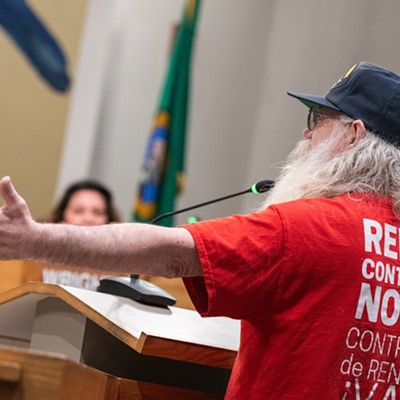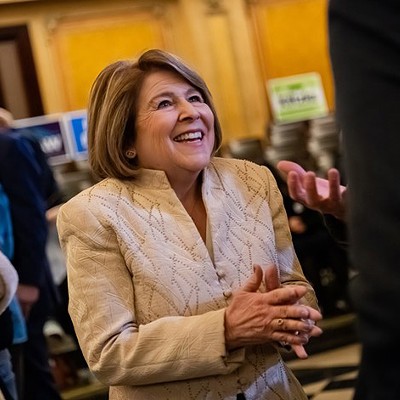Safe Arbor Harbor
[
{
"name": "Broadstreet - Instory",
"component": "25846487",
"insertPoint": "4",
"requiredCountToDisplay": "4"
},{
"name": "Broadstreet - Empower Local",
"component": "27852456",
"insertPoint": "8",
"requiredCountToDisplay": "8"
},{
"name": "Broadstreet - Instory",
"component": "25846487",
"insertPoint": "12",
"requiredCountToDisplay": "12"
},{
"name": "Broadstreet - Instory - 728x90 / 970x250",
"component": "27852677",
"insertPoint": "18",
"requiredCountToDisplay": "18"
},{
"name": "Broadstreet - Instory",
"component": "25846487",
"insertPoint": "5th",
"startingPoint": "23",
"requiredCountToDisplay": "24",
"maxInsertions": 100
}
]
by Gabor Zovanyi & r & & r & & lt;span class= "dropcap " & I & lt;/span & n November 2004, citizens of Spokane approved a street-bond program to address the sorry state of many city streets. This spring, Spokane will undertake a project using this funding to reconstruct Bernard Street between 14th and 29th avenues. That project, as proposed by the city's Engineering Services Department, will remove 22 street trees. In one of his first acts as mayor, Dennis Hession has sided with the city's traffic engineers, supporting the proposed tree removal.
According to a report prepared by the city's arborist, half the trees are too damaged by storms and improper trimming to be saved anyway, and the remaining trees would not survive the street reconstruction disturbance. To compensate for the loss of street trees, Hession told citizens the city would plant 24 new trees. These replacement trees, however, would not be planted in the pedestrian buffer strip separating sidewalks from the street. Instead, with property owner permission, they could be placed beyond the sidewalks on lawns removed from the street, or even on other city streets. As a result, Bernard would lose what little it currently has in street trees to soften the impact of 40 feet of asphalt pavement.
The Cliff/Cannon and Manito neighborhood councils have both passed resolutions opposing the Bernard project's focus on improving a roadway at the expense of street trees. The resolutions call on the city to postpone the Bernard project until a design scheme is developed that incorporates pedestrian and tree considerations. That design could, for example, reduce or eliminate the rarely used parking lanes on both sides of Bernard, re-using that captured space to create wider buffer strips capable of protecting some of the existing street trees while providing space for more even street trees along Bernard.
Additionally, that space could incorporate enhanced public facilities for pedestrians and bicyclists, which, along with the street trees, would create a grand portal for residents and tourists traveling from downtown to Manito Park and the Japanese Garden. The city's comprehensive plan includes policies that support such a design alternative for its roadways.
A neighborhood policy on pedestrian buffer strips states that it is city policy to "require that sidewalks be separated from the street by a pedestrian buffer strip on all new or redeveloped streets to provide a safe place to walk." A policy on pedestrian buffer strips states that, "where traffic calming is desired, large street trees are preferred." A policy on street trees states that the city should "plant street trees wherever possible to enhance the transportation environment." Another urban forestry policy on street trees states that it is city policy to "plant trees along all streets" and that "street trees planted in buffer strips between the curb and sidewalk should be included in every street project." That same policy goes on to state that the city should "not allow tree removal in the public right-of-way without a program for tree replacement."
If this isn't enough to call into question the current plans for Bernard, the adopted comprehensive plan states that, "Public improvements through the investment of public capital funds, regardless of the source, are to conform to and implement the comprehensive plan."
It seems that if the mayor and city council merely followed their own adopted policies in the comprehensive plan -- and evaluated any development proposal for consistency with that plan -- they would have to reject the proposed Bernard reconstruction project.
In addition to violating the city's comprehensive plan, the proposed Bernard project should be questioned on a number of other grounds. Research has shown that mature trees add thousands of dollars to the value of residential structures. The proposed replacement trees will simply fail to match the value of the trees slated for removal. Consequently, the project would reduce the value of residences and thereby diminish the city's tax base. Does this represent sensible policy when the city is strapped for revenue? Street trees are also a defining characteristic of many South Hill neighborhoods. Should city actions be permitted to degrade this fabulous amenity?
Perhaps the most disturbing aspect of the Bernard proposal is the precedent it would set for future road reconstruction projects. A similar bond-funded street-improvement project is scheduled for Lincoln. Will trees on that street and on other streets scheduled for reconstruction also have to come down in order to realize future street improvements? Does the Bernard project set the stage for an ongoing elimination of street trees throughout the city? If so, what kind of example is being set for private developers by this project?
The mayor and city council have an alternative to this ill-conceived proposal. They could honor the wishes of citizens expressed through neighborhood councils and postpone the Bernard project until a new design consistent with the city's comprehensive plan is developed. Such a design would incorporate the needs of drivers, pedestrians, and cyclists. Rather than reducing the number of trees in our urban forest, we should be increasing them.
Gabor Zovanyi is a professor of urban planning at Eastern Washington University.
According to a report prepared by the city's arborist, half the trees are too damaged by storms and improper trimming to be saved anyway, and the remaining trees would not survive the street reconstruction disturbance. To compensate for the loss of street trees, Hession told citizens the city would plant 24 new trees. These replacement trees, however, would not be planted in the pedestrian buffer strip separating sidewalks from the street. Instead, with property owner permission, they could be placed beyond the sidewalks on lawns removed from the street, or even on other city streets. As a result, Bernard would lose what little it currently has in street trees to soften the impact of 40 feet of asphalt pavement.
The Cliff/Cannon and Manito neighborhood councils have both passed resolutions opposing the Bernard project's focus on improving a roadway at the expense of street trees. The resolutions call on the city to postpone the Bernard project until a design scheme is developed that incorporates pedestrian and tree considerations. That design could, for example, reduce or eliminate the rarely used parking lanes on both sides of Bernard, re-using that captured space to create wider buffer strips capable of protecting some of the existing street trees while providing space for more even street trees along Bernard.
Additionally, that space could incorporate enhanced public facilities for pedestrians and bicyclists, which, along with the street trees, would create a grand portal for residents and tourists traveling from downtown to Manito Park and the Japanese Garden. The city's comprehensive plan includes policies that support such a design alternative for its roadways.
A neighborhood policy on pedestrian buffer strips states that it is city policy to "require that sidewalks be separated from the street by a pedestrian buffer strip on all new or redeveloped streets to provide a safe place to walk." A policy on pedestrian buffer strips states that, "where traffic calming is desired, large street trees are preferred." A policy on street trees states that the city should "plant street trees wherever possible to enhance the transportation environment." Another urban forestry policy on street trees states that it is city policy to "plant trees along all streets" and that "street trees planted in buffer strips between the curb and sidewalk should be included in every street project." That same policy goes on to state that the city should "not allow tree removal in the public right-of-way without a program for tree replacement."
If this isn't enough to call into question the current plans for Bernard, the adopted comprehensive plan states that, "Public improvements through the investment of public capital funds, regardless of the source, are to conform to and implement the comprehensive plan."
It seems that if the mayor and city council merely followed their own adopted policies in the comprehensive plan -- and evaluated any development proposal for consistency with that plan -- they would have to reject the proposed Bernard reconstruction project.
In addition to violating the city's comprehensive plan, the proposed Bernard project should be questioned on a number of other grounds. Research has shown that mature trees add thousands of dollars to the value of residential structures. The proposed replacement trees will simply fail to match the value of the trees slated for removal. Consequently, the project would reduce the value of residences and thereby diminish the city's tax base. Does this represent sensible policy when the city is strapped for revenue? Street trees are also a defining characteristic of many South Hill neighborhoods. Should city actions be permitted to degrade this fabulous amenity?
Perhaps the most disturbing aspect of the Bernard proposal is the precedent it would set for future road reconstruction projects. A similar bond-funded street-improvement project is scheduled for Lincoln. Will trees on that street and on other streets scheduled for reconstruction also have to come down in order to realize future street improvements? Does the Bernard project set the stage for an ongoing elimination of street trees throughout the city? If so, what kind of example is being set for private developers by this project?
The mayor and city council have an alternative to this ill-conceived proposal. They could honor the wishes of citizens expressed through neighborhood councils and postpone the Bernard project until a new design consistent with the city's comprehensive plan is developed. Such a design would incorporate the needs of drivers, pedestrians, and cyclists. Rather than reducing the number of trees in our urban forest, we should be increasing them.
Gabor Zovanyi is a professor of urban planning at Eastern Washington University.
















